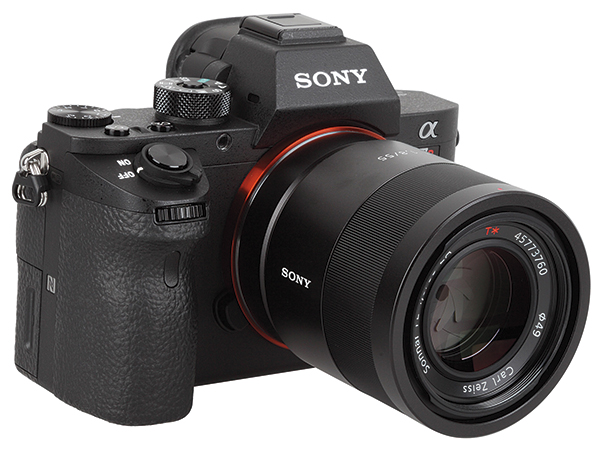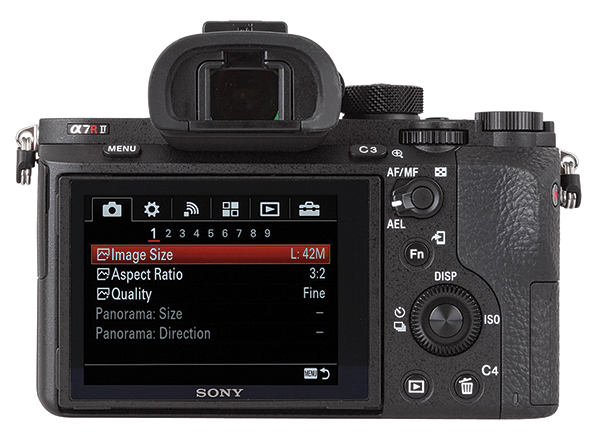Sony A7R II Mirrorless Camera Review

(Editor's Note: Lab Review lab tests and comments are supplied by BetterNet, Shutterbug’s TIPA-affiliated testing lab and edited by George Schaub. Shutterbug is the sole US representative within TIPA, a worldwide association of photo and imaging magazines. You can see our Field Test Review of the Sony A7R II with full resolution test images here.)
The Sony A7R II is a mirrorless, compact system camera with a full-frame sensor and extremely high resolution. The A7R II records images with 7952x5304 pixels and while the more than 42MP resolution is not as high as the sensor resolution of the Canon EOS 5DS, it provides images on the same level as digital backs for medium format cameras.


Build, Layout & Performance
The Sony A7R II features very fast autofocus (AF) with a hybrid focusing system that combines contrast- and phase-detection systems, with the phase-detection sensors located directly on the image sensor. It offers 399 AF areas for fast and versatile focus settings. The A7R II shows the constantly moving and varying focus areas in AF mode on its screen or its electronic viewfinder. The AF system is highly configurable and very fast. (One note: We have talked with some photographers who are using Canon EF lenses mounted by a Metabones adapter to the Sony A7R II, which allows for automatic focusing. They have told us that the speed of the Canon EF/Sony AF combination may not reach the speed of a real Canon EF SLR focus system or the speed of the A7R II with its own E-mount lens system, but nevertheless is comparable to cameras with fast AF contrast metering.)
The Sony A7R II has a large electronic viewfinder that corresponds to a DSLR with 0.78x optical scaling. Its monitor system is based on OLED technology and offers a resolution of 2.36 million RGB dots. The combination of large viewfinder scaling, high resolution, and OLED technology (with additional Zeiss T* coating for the viewfinder) offers a very bright, crisp and clear viewfinder experience. In addition, it shows additional information as a digital overlay on the screen (for example, electronic leveling).
The A7R II has a swivel LCD on the back with 1.288 million RGB dots; it isn’t fully articulated, but can be flipped up- and downward. The camera features five-axis image stabilization, which compensates for camera shake along five axes during shooting, including angular shake (pitch and yaw), which can occur when shooting with a telephoto lens; shift shake (X and Y axes); and rotational shake (roll), which typically affects video recording. Sony claims a benefit of 4.5 EV stops with this system.
Comments On Image Quality
Color: The Sony A7R II showed an excellent performance in our color test. The white balance system tends toward cooler colors; only very bright gray and white nuances show a shift into the yellow direction, but these effects are on a very low level. The level of color errors in general is low, with only some blue nuances and red colors boosted, resulting in a mean saturation of 107.8 percent. Skin tones are “optimized” by a slightly higher magenta rate, but overall look great.
Sharpness: All test shots done with the Sony A7R II were conducted with the Sony Zeiss Sonnar T* FE 55mm F1.8 ZA. The camera showed an excellent performance in our resolution tests and reproduced the ISO 12.233 chart with 5,016 lines (of 5,304 lines on the sensor). High resolution and excellent detail reproduction is also noticeable in our test images. The camera achieved the high-resolution result with only a very slight sharpness and enhancement filtering (done by the image processor) and created images with a very natural look. However, the extremely high resolution can only be achieved in a small range of the chosen aperture size. The maximum result was achieved in an image shot with f/5.6. Using narrower apertures caused diffraction blur, for example, which we noticed in images taken with f/8 to f/11. (Note: The Canon EOS 5DS has the same problem. The very high sensor resolution causes higher vulnerability for these effects.)
Noise: The new Sony showed a very excellent performance in our noise tests. The luminance noise factor/y-factor is very low in images taken with ISO 100 to 1600. Images taken with ISO 100 to 1600 look very clean because color noise is also nearly invisible. In images taken with ISO 3200 some “grain” effects start to become visible, but even in files shot with ISO 6400 these effects are on a very low level. The combination of color noise and anti-noise filtering becomes visible in images taken with ISO 12,800 and gets really annoying in images taken with ISO 25,600.
The two additional high modes become problematic: at ISO 51,200 detail reproduction is reduced significantly; at ISO 102,400 we noticed very intense color noise artifacts and reduced sharpness/details. Nevertheless, these noise results are very good for a sensor with very high pixel density. The dynamic range results are very good. The camera achieved a maximum of 11 f/stops and keeps a high level of more than 10 f/stops in images taken with ISO 100 to 6400. Dynamic range results can be improved by using the extensive “dynamic range settings” in the image mode or by shooting Raw image format.

Comments On Video Functions
The Sony A7R II is the first camera of the A7 series that is able to record 4K videos on its internal storage device (the A7S is able to record 4K videos on an external recorder via HDMI). In 4K mode, the camera records with 3840x2160 pixels, which is the UHDTV standard, yet it doesn’t offer a “real cinema” 4K mode with 4096x2160 pixels.
In 4K mode the Sony is able to record videos with up to 25/30 frames per second. In Full HD mode it can record videos with up to 60 frames per second. The Sony uses various video file formats. It can record movies in AVCHD 2.0 mode and Full HD resolution, which is the same file format many camcorders use. For 4K recording it offers MP4 and Sony’s XAVC S file format that uses H.264 compression technology but features higher data rates. The camera can record its video sequences with up to 100 Mbit/s. To reach higher data rates it has to be loaded with the most current SD cards. The camera indicates “wrong media systems” (if older SD cards are loaded) when the high data rate modes are selected.
The Sony offers numerous color and picture styles for video recording. It can be used in “SLog2” color mode, which creates very flat and desaturated videos, but offers increased flexibility in color correction software to enhance dynamic range and contrast reproduction among other features. These modes are normally offered by professional video cameras.
The A7R II allows manual setup of all recording parameters. The user can change P, S, A, and M mode for video recording and can set up ISO speed manually. To support manual focusing the camera offers “focus peaking” and a magnifier function on its screen. The sound level settings also offer manual control.
There is only one feature that is a bit “unprofessional.” The additional shutter release button for video recording is located on the right-hand side of the camera body, which we found made video recording selection a bit uncomfortable.

Comments On Video Quality
The Sony showed a very good performance in our video tests. The ISO 12.233 chart was reproduced with 838 lines per picture height in 1080p mode and 1,647 lines per picture height in 4K mode.
In video mode, the Sony showed the same behavior in color reproduction as in photo mode. All colors have a very natural look and only some nuances are a little boosted. The white balance system did a very good job and colors look neutral.
Noise level at ISO 100 to 3200 is also comparable to images taken in photo mode. The camera offers smooth and clean and highly detailed video sequences. Color noise gets visible in videos taken with ISO 6400 and gets really annoying in videos with ISO 12,800 and ISO 25,600. The dynamic range results are also comparable: the camera achieved a maximum of 10.9 f/stops.
Scorecard
Pros
› Mirrorless system camera with 42MP resolution
› Large electronic viewfinder with high resolution
› High image quality (crisp sharpness, nice colors)
› Highly configurable due to many individual settings
› Better handling thanks to a revised body design
› Powerful, built-in image stabilizer (five-axis system)
› Very fast AF system
› Professional video features (including 4K and “SLog2” color space)
› Wi-Fi
Cons
› Awkward placement of video button
› Missing built-in flash
› Missing GPS system (GPS data available via Wi-Fi connection to smartphone)
The Sony A7R II has a list price of $3,199 (body only). For more info, visit sony.com.
- Log in or register to post comments

















































